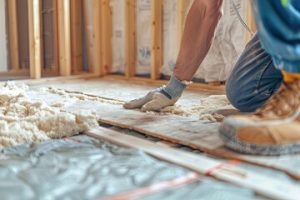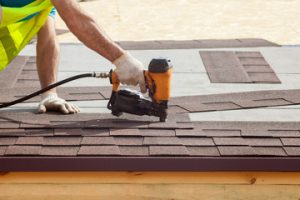Ceiling Insulation Pert helps regulate indoor temperature, keeping heat inside during winter and preventing it from entering in summer. This reduces the strain on heating and cooling systems, which in turn lowers energy bills.

Some insulation materials are DIY-friendly, while others, like spray foam and blown-in insulation, require professional installation. Each option has different cost considerations, including material and labor costs.
Ceiling insulation is a cost-effective way to reduce energy use in the home. It minimizes heat loss during the winter and keeps warm air in during the summer, reducing dependence on heating or cooling systems to maintain a comfortable indoor environment. It also acts as a moisture barrier, which helps prevent the build-up of mold and mildew in roof spaces.
As the average household spends over 50 percent of its energy bills on heating and cooling, effective insulation can significantly cut these costs. Insulation slows down the transfer of heat and cold, allowing for heating or cooling systems to work more efficiently. This in turn results in reduced power consumption and lower utility bills.
Energy efficiency is a significant consideration for new homes, especially in the face of ever-increasing electricity costs. In fact, it is now a requirement for all new homes to meet SANS 10400-XA energy efficiency regulations. However, many new homes are not meeting these standards, with inspectors signing them off with minimal or nonexistent insulation.
A professional approach to ceiling insulation can ensure compliance with energy efficiency regulations and the creation of a comfortable, efficient living space. It is important to compare quotes from reputable insulation contractors to ensure you’re getting the best value and quality for your money.
Different types of insulation are available, each with its own advantages and benefits. For example, fiberglass batts are a common choice because of their ease of installation and cost-effectiveness. They are made of tiny glass fibers and can be found in varying widths to suit standard joist spacings. They offer moderate thermal resistance and are treated with fire retardant chemicals for safety. Cellulose is an alternative to fiberglass batts and is environmentally friendly. It is made from recycled paper products and treated with fire-retardant chemicals. It is typically blown in place and is ideal for filling hard-to-reach spaces. It offers good thermal resistance and soundproofing qualities. However, it is made from non-renewable materials and is not biodegradable, which could present some environmental concerns. This is why it is essential to consider your personal and energy usage needs when selecting the right insulation for your home.
Reduced Noise
Ceiling insulation can help reduce noise from neighbours or traffic, creating a quieter living environment. Insulation can also improve acoustic performance in multi-storey buildings by reducing sound transmission between floors. The type of insulation you choose will depend on whether your priority is energy efficiency or acoustic reduction. Thermal insulation keeps heat inside in winter and reflects it away in summer, reducing power bills and energy consumption. Acoustic insulation, on the other hand, stops sound waves from reverberating throughout your home, preventing unwanted noise and aggravation from disturbing your family and guests.
The best ceiling insulation for acoustic reduction is made of materials like fiberglass and cellulose, which contain air pockets that trap sound waves, diminishing their power and reducing the amount of noise they make. These insulation options are ideal for reducing both airborne noise and impact sound (such as footsteps or the sound of doors closing).
To maximise the noise-reducing capabilities of your new ceiling, opt for insulation that has an STC rating between 3.1 and 3.8 per inch. The higher the STC rating, the more effective the insulation is. In addition, the thickness and density of the insulation will impact its noise-reducing abilities. Thicker or denser insulation will generally offer better noise reduction, but it may not always be practical due to cost or space limitations.
Another way to increase your acoustic insulation is to install a decoupling sound isolation clip to the ceiling joists. These clips utilise dual fixing points and combine steel for strength with antivibration rubber to absorb vibration sounds. These clips can be installed on timber or concrete ceilings and are available in a range of sizes to suit your new ceiling.
Ceiling insulation is a simple, low-cost way to improve your home’s energy efficiency and comfort levels. It’s also a smart investment that pays for itself with lower electricity bills and reduced energy consumption. For a complete, comprehensive solution, contact a trusted and experienced insulation specialist. GreenMatch can connect you with up to four free, customised quotes from leading insulation contractors in your area. Simply fill out the 30-second form below to get started!
Reduced Drafts
Ceiling insulation helps to trap cool air in the summer and warm air in the winter, making it easier for heating and cooling systems to operate at full capacity. This reduces drafts and improves comfort by maintaining a consistent indoor temperature throughout the year. It also saves energy, which cuts utility bills and reduces environmental emissions.
Ceiling Insulation is also beneficial in reducing noise transmission between rooms and between floors. Insulation materials such as mineral wool and dense fiberglass are effective at reducing sound and make it easy for people to carry on conversations without disturbing others.
When properly installed, insulation can also prevent condensation and mold in the attic. Insulation keeps water vapor from diffusing into walls and ceilings during cold weather, which can lead to wood rot and other structural problems. In addition, a vapor barrier (also known as a vapor permeable moisture retarder) can be installed to prevent the diffusion of moisture into the walls and ceiling.
Insulation can be installed in a variety of ways, depending on the needs of the homeowner or building owner. For new construction projects, insulation can be blown into place or poured in. It can also be fabricated into ducts, which is often done by HVAC contractors.
Spray foam insulation is a popular option, as it is effective at filling gaps and cracks, sealing leaks and creating an airtight seal. It can be applied to the underside of the ceiling or in a space behind the attic floor. It is more expensive than other types of insulation, however.
The R-value of the insulation is another important consideration, as it determines its effectiveness. Generally speaking, the higher the R-value, the better the insulation.
The type of insulation you choose should also depend on your climate zone. Southern climate zones are considered “cooling dominated,” while northern climate zones are considered “heating dominated.” In general, insulation solutions differ slightly between these regions and the R-values recommended may change. The best way to determine the R-value for your area is to use a tool that takes into account your climate zone, the R-value of your existing insulation and the type of home or building you have.
Increased Comfort
As the largest area of space in a home, the ceiling is one of the best places for energy efficiency improvements. Insulation in the ceiling slows down the transfer of heat so that your furnace doesn’t have to work as hard to keep rooms warm during winter and cool during summer. In turn, this reduces the wear and tear on your heating and cooling system, extends its life, and saves you money on energy costs.
In addition to energy savings, ceiling insulation improves indoor comfort by reducing temperature fluctuations and minimizing noise pollution. Some insulation materials also act as sound absorbing barriers, further enhancing the overall feeling of a living or working environment.
Vaulted ceilings are popular with homeowners for their aesthetically pleasing look and ability to lighten a room, but if they’re not properly insulated, they can let hot air escape upward. Insulating vaulted ceilings prevents this unwanted energy loss and significantly reduces energy bills.
The soffit and ridge vents should be sealed and any electrical wiring or chimneys should be closed off before installing insulation, to prevent heat leakage. Using foam insulation such as spray foam is a great option for sealing gaps and providing an airtight barrier, further reducing energy costs.
Choosing the right type of insulation for your ceiling will depend on the size of your home, your climate, and your budget. For instance, fiberglass and cellulose insulation are easy to install but may not be as effective in colder climates, while spray foam expands to fill the gaps between joists or rafters for improved energy efficiency.
It’s important to contact a local insulation professional with experience and training to ensure your project is performed correctly. A reputable insulation company will provide comprehensive consultation, installation services, and support after completion of your home improvement project.
If you’re building a new home or conducting major renovations that involve the ceiling, incorporating insulation during construction is ideal, as it allows for easier access and ensures proper installation without disturbing existing structures. The fall and spring are also good times to insulate, as these seasons are milder with less humidity, making them more comfortable for workers and homeowners.

